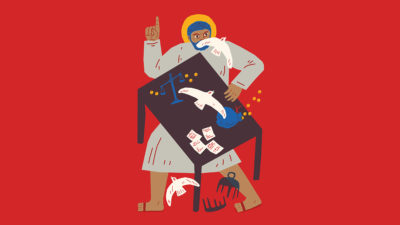Read this article in the limited edition print version: order a copy here.
Fr John Dear’s book, The Sacrament of Civil Disobedience, is being brought back into print by the Passionists’ publishing imprint, Lab/ora Press: freshly edited, with a rabble-rousing foreword by activist and author Shane Claiborne. Within, Fr John draws on the rich tradition of civil disobedience in the Christian faith, and outlines a civil resister’s field guide for discernment, best practice, and even our approach to jail time. In this extract, Fr John introduces Jesus as the master of nonviolent civil disobedience: the truth-seeker and risk-taker prepared to face death for the cause of God’s reign of nonviolence.
Illustration by Benji Spence
Mohandas Gandhi, the great twentieth century apostle of nonviolence, once wrote that “Jesus was the most active resister known perhaps to history.” Jesus was a peacemaker who time and time again broke the laws that oppressed people and kept them slaves to injustice. Much that Jesus did was nonviolent, illegal, provocative, civilly disobedient and divinely obedient. Jesus was a nonviolent resister; indeed, a steadfast practitioner of nonviolent civil disobedience—a troublemaker par excellence.
His entire life led up to the culminating confrontation with the powers of his day, symbolized in the oppressive cult of the Temple system. His civil disobedience in the Temple provoked the ruling authorities to arrest Jesus. They were afraid that his followers among the poor in the countryside would try to do likewise. So, he was imprisoned, tried, interrogated, tortured, and publicly executed by the ruling authorities. After his murder—through the legal channel of the death penalty—Jesus rose from the dead: another act in his series of nonviolent acts of civil disobedience to the imperial/religious authorities. His resurrection was nonviolent and illegal; indeed, totally outside of the law and its “principalities and powers.”
The evangelists are clear on this point: Jesus was unambiguous. His disciples tried to talk him out of going to Jerusalem, but Jesus would hear none of that. He went to Jerusalem, fully conscious of the implications and consequences. He would speak the truth, dramatically, symbolically, at the center of the culture of death. He would turn over the tables of that culture, if necessary, but he would speak. He would insist on the truth. He would be obedient to God’s will. He would make himself available to all.
He was willing to be rejected, willing to risk his life, but he would go and speak up for what was right. Jesus was a walking force of nonviolence. He was the living Spirit of the reign of nonviolence, walking amid the kingdom of violence. He lived the truth, and in his death, became Truth. His actions were the committed response of someone on fire with love and truth.
Thus, he was dramatic. He was symbolic. And he was willing to stand up to the principalities and powers and face every level of violence, including arrest, jail, trial, torture, and death by crucifixion. As a force of nonviolence, he would confront all these evils and overcome them through suffering love.
In trying to respond to this challenge, few followers of Jesus dare to take the road to Jerusalem in their own lives. This is understandable: the consequences are still as severe as in Jesus’ day—arrest, imprisonment, and, in some situations, torture and execution. Yet, following the leadership of Gandhi, Day, King and others during the twentieth century, a new strength has been given to Christians and truth-seekers regarding the road to Jerusalem: a way to re-read the Gospel through the eyes of nonviolence. What Jesus revealed was a Spirit committed to love and truth, and a way to live out that Spirit in a world of hostility and un-truth. Jesus’ life, words and actions are the way of nonviolent resistance.
From this new perspective, this new hermeneutic re-learned from the court and the jail cell, the Gospel of Jesus reads as a manifesto of nonviolent civil disobedience to systemic violence and societal sin. It becomes clearer that the Gospel of Jesus commands active nonviolence. Everything in Jesus’ life is seen as one illegal act of peacemaking after another.
Jesus was stubborn, insistent and determined: he would do everything he could, even if that meant going outside imperial and religious law, to reveal the reign of God. Once we understand the world as a reign of violence into which God is bringing forth God’s reign of nonviolence, Jesus’ life becomes a testimony of nonviolent civil disobedience as a way to challenge the kingdom of violence and death.
The Gospels portray Jesus as acting publicly to reveal the reign of God present in the world. They present a series of actions that build up to a crescendo in Jerusalem, where Jesus commits his greatest action: turning over the tables in the Temple; an act of peaceful, loving disobedience and truth-telling.
All his actions vary in focus and intensity; many are illegal and draw the ire of the ruling and religious authorities. But the three synoptic Gospels tell us it is the Temple action which leads to his arrest and execution. After his death, through the power of God, Jesus commits still another illegal act: he rises from the dead, and sets out inspiring people to the same series of subversive nonviolent acts.
His life is beyond our wildest dreams; but he says to us, “Believe it. Come, follow me as I turn over the tables of this culture of death.” Jesus commands his followers to do as he did, to follow the spirit in the reign of nonviolence and its challenge to the kingdom of violence and oppression, even to the point of death, and then beyond, to resurrection.
“Jesus was stubborn, insistent and determined; he would do everything he could, even if that meant going outside imperial and religious law, to reveal the reign of God.”
Jesus remained faithful to God. His execution was a political event, as the trial accounts show. The forces of the empire brought the full brunt of their legalized violence down on Jesus. They used their ultimate weapon against him: he was put to death.
Yet, as the scripture recounts, the world had only just begun to see his weapon of nonviolence. God raised Jesus from the dead, and this resurrection was the ultimate act of nonviolent civil disobedience. God disobeyed the imperial code of law which says that the empire has the last word: when someone is executed, according to imperial logic, that person is supposed to stay dead. According to the logic of God—the logic of nonviolence—suffering love and truth-telling always lead to resurrection and life.
On the first day of the week, when Jesus’ women friends went to anoint his body, they found the tomb empty. A young man, dressed in white, told them not to be afraid, but to get the others and go to Galilee where they would find him.
Jesus had risen and gone back immediately to Galilee, to the outskirts of the empire, into the land of the poor where he had started his nonviolent revolution. He was starting all over again! This time, his disciples would know the outcome: they would speak out publicly against the forces of oppression and injustice, risk arrest and death, and share in the resurrected life of the Christ.
The resurrection inspired the disciples to practice nonviolent civil disobedience towards the ruling authorities of the day, as a way of life. Shortly thereafter, the community of followers grew and multiplied and were martyred in large numbers by the imperial regimes. The resurrection gave them new life, hope, and the courage to continue resisting injustice and proclaiming justice for all.
The poetic story of Jesus’ life, as told in the Gospel of John, ends with a resurrection episode of particular boldness. John’s Gospel was written long after the others, perhaps seventy years after the death of Jesus. In the first account of Jesus’ appearance to the disciples, Thomas was absent. When told that Jesus had appeared and offered them his peace, he laughed it off, saying, “I will never believe it without probing the nail-prints in his hands, without putting my finger in the nail-marks and my hand into his side.”
A week later, Jesus appeared to the disciples—Thomas among them. Jesus said to Thomas, “Take your finger and examine my hands. Put your hand into my side. Do not persist in your unbelief, but believe!”
“My Lord and My God,” Thomas declared as he fell in worship before Christ.
Thomas’ response to the risen Jesus became the proclamation of the early church, the community of believers and resisters. But the words ‘My Lord and My God’ were not just pious words uttered to Jesus in a prayer; they were political words of revolution. This creed, as a statement of belief, was an act of nonviolent civil disobedience.
A law had been passed declaring that the emperor was to be addressed from then on as ‘My Lord and My God’. Addressing Jesus with this title was not only an act of faith and an expression of love for Jesus: it was a highly illegal act. It broke the law. As far as the empire was concerned, it was an act of political blasphemy, because the emperor was god. The followers of Jesus who used this title, as John’s Gospel hints, had taken up the way of nonviolent civil disobedience. They were no longer servants of the emperor; they had finally become followers of Jesus.
Today, we too are called to be a people who address Jesus—not the culture, the system, Wall Street or the state—as our Lord and our God. We are called to be people of the resurrection. As followers of Jesus, we take up where he left off: with the illegal work of nonviolent civil disobedience.
You can pre-order The Sacrament of Civil Disobedience from our publishing imprint, Lab/ora Press or from all major online bookstores from mid-November.
Related Stories

Experiences of Passionist prayer, pt. 3: Joanne Crompton
How do we pray? What role does prayer take in our lives? We asked three people pursuing a Passionist spirituality how their sense of prayer has changed over time.
Jul 05 2023

Experiences of Passionist prayer, pt. 2: Bishop William Kenney
How do we pray? What role does prayer take in our lives? We asked three people pursuing a Passionist spirituality how their sense of prayer has changed over time.
Jun 24 2023

Experiences of Passionist prayer, pt. 1: Michael O’Halloran
How do we pray? What role does prayer take in our lives? We asked three people pursuing a Passionist spirituality how their sense of prayer has changed over time.
Jun 18 2023




